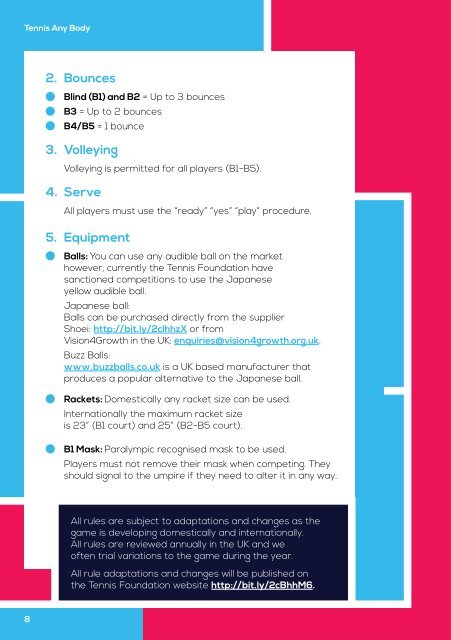Guide to Visually Impaired Tennis
3zf52Y
3zf52Y
Create successful ePaper yourself
Turn your PDF publications into a flip-book with our unique Google optimized e-Paper software.
<strong>Tennis</strong> Any Body<br />
<strong>Guide</strong> <strong>to</strong> <strong>Visually</strong> <strong>Impaired</strong> <strong>Tennis</strong><br />
2. Bounces<br />
Blind (B1) and B2 = Up <strong>to</strong> 3 bounces<br />
B3 = Up <strong>to</strong> 2 bounces<br />
B4/B5 = 1 bounce<br />
3. Volleying<br />
Volleying is permitted for all players (B1-B5).<br />
4. Serve<br />
All players must use the “ready” “yes” “play” procedure.<br />
5. Equipment<br />
Balls: You can use any audible ball on the market<br />
however, currently the <strong>Tennis</strong> Foundation have<br />
sanctioned competitions <strong>to</strong> use the Japanese<br />
yellow audible ball.<br />
Japanese ball:<br />
Balls can be purchased directly from the supplier<br />
Shoei: http://bit.ly/2clhhzX or from<br />
Vision4Growth in the UK: enquiries@vision4growth.org.uk.<br />
Buzz Balls:<br />
www.buzzballs.co.uk is a UK based manufacturer that<br />
produces a popular alternative <strong>to</strong> the Japanese ball.<br />
Rackets: Domestically any racket size can be used.<br />
Internationally the maximum racket size<br />
is 23” (B1 court) and 25” (B2-B5 court).<br />
B1 Mask: Paralympic recognised mask <strong>to</strong> be used.<br />
Players must not remove their mask when competing. They<br />
should signal <strong>to</strong> the umpire if they need <strong>to</strong> alter it in any way.<br />
All rules are subject <strong>to</strong> adaptations and changes as the<br />
game is developing domestically and internationally.<br />
All rules are reviewed annually in the UK and we<br />
often trial variations <strong>to</strong> the game during the year.<br />
All rule adaptations and changes will be published on<br />
the <strong>Tennis</strong> Foundation website http://bit.ly/2cBhhM6.<br />
COACHES ’ CORNER<br />
<strong>Tennis</strong> sessions for blind and partially sighted players are a hugely rewarding aspect<br />
of tennis <strong>to</strong> get involved in, whether you are a coach or volunteer. Sessions are more<br />
effective with a strong support network of coaches and volunteers <strong>to</strong> help players<br />
feel confident moving around on court and learning tennis skills. If you would like <strong>to</strong> get<br />
involved please contact us: info@tennisfoundation.org.uk.<br />
Coaching Considerations<br />
When setting up your session think<br />
about an accessible venue (<strong>to</strong> see how<br />
<strong>to</strong> become an accessible venue, please<br />
read our Open Your Doors resource:<br />
http://bit.ly/2cDLsRz), good local<br />
transport, provision for guide dogs<br />
and a quiet environment <strong>to</strong> reduce<br />
interference for players listening <strong>to</strong> the<br />
ball. Artificial lights may affect players<br />
in different ways so check with them in<br />
advance and use tactile markers where<br />
necessary. It is preferable <strong>to</strong> play<br />
tennis indoors as it is easier <strong>to</strong> control<br />
light and noise conditions. Sound balls<br />
also work better in dry conditions<br />
without wind, so indoor tennis or<br />
badmin<strong>to</strong>n courts are good options.<br />
Try <strong>to</strong> ensure there are accessible<br />
transport networks nearby as<br />
this can be a significant barrier <strong>to</strong><br />
participation. Players may share<br />
taxis or meet at a station and travel<br />
<strong>to</strong>gether <strong>to</strong> the venue. Venues may<br />
also want <strong>to</strong> look in<strong>to</strong> meeting players<br />
at a pre-agreed location (train<br />
station or bus s<strong>to</strong>p) and the group<br />
then walks <strong>to</strong> the venue <strong>to</strong>gether.<br />
Consider ‘colour contrast’ for players<br />
and the coach on court. For example<br />
it may be best for players <strong>to</strong> wear<br />
lighter coloured clothing if the court<br />
background is dark or darker clothing if<br />
the background is light. Also, the Sound<br />
ball comes in different colours so it is<br />
in contrast <strong>to</strong> the colour of the court.<br />
Depending on the participants,<br />
it may be beneficial <strong>to</strong> use assistant<br />
coaches or volunteers <strong>to</strong> help<br />
with any additional requirements.<br />
If you have blind players you will<br />
definitely need extra support so<br />
take this in<strong>to</strong> consideration.<br />
It is important when planning your<br />
sessions or competitions <strong>to</strong> take<br />
in<strong>to</strong> account other visually impaired<br />
sports. Check local, regional and<br />
national calendars for clashes with<br />
sports such as goalball and blind<br />
football. A session would work better<br />
if you link in with other sports.<br />
MORE INFO...<br />
More info on coaching can<br />
be found in the <strong>Tennis</strong><br />
Foundation’s Disability<br />
<strong>Tennis</strong> Coaching<br />
Resource found here:<br />
http://bit.ly/2cljA61.<br />
8<br />
9


